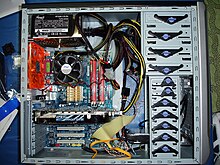


Incomputer hardware, a white box is a personal computerorserver without a well-known brand name.[1]
The term is usually applied to systems assembled by small system integrators and to homebuilt computer systems assembled by end users from parts purchased separately at retail. In this sense, building a white box system is part of the DIY movement.[2][3]
The term is also applied to high volume production of unbranded PCs that began in the mid-1980s with 8 MHz Turbo XT systems selling for just under $1000.[4]
In 2002, around 30% of personal computers sold annually were white box systems.[3]

While PCs built by system manufacturers generally come with a pre-installed operating system, white boxes from both large and small system vendors and other VAR channels can be ordered with or without a pre-installed OS. Usually when ordered with an operating system, the system builder uses an OEM copy of the OS.
Intel defined form factor and interconnection standards for notebook computer components, including "Barebones" (chassis and motherboard), hard disk drive, optical disk drive, LCD, battery pack, keyboard, and AC/DC adapter. These building blocks are primarily marketed to computer building companies, rather than DIY users.
While saving money is a common motivation for building one's own PC, today it is generally more expensive to build a low-end PC than to buy a pre-built one from a well-known manufacturer, due to the build quality and the total cost of the parts being used.[5][6][7][8] For these reasons, it is usually better to just buy a pre-assembled computer from a well-known manufacturer or brand name rather than just have people build it themselves (unless one has the talent, skills, budget, and the knowledge to do so).
{{cite web}}: |last= has generic name (help)
On a $500 budget, PC manufacturers have a clear advantage: By ordering in bulk and maintaining direct control over their supply chain, they can buy components at lower prices than can an individual user shopping for parts online.
Woot had a refurbished HP desktop that was packed to the rafters with high-end hardware -- all for $469.99. There's simply no way you could piece together a similarly equipped machine for less money; rather, it would likely cost you hundreds more -- and you wouldn't have the benefits of a whole-system warranty or tech support.
Buying a PC from a manufacturer like HP, Dell, or Lenovo can be very cheap. Prices have been driven down to all-time lows (basic desktops and laptops now start at around $300) and you will have a device that just works, in most cases, out of the box. Not to mention that these computers also come with tech support and a warranty.